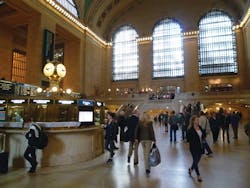Make No Small Plans
Since its opening in 1913, Grand Central Terminal in New York City has served as a hard-working monument to public transportation. As I marveled at the bustle of travelers and the spectacular architecture, it was difficult to imagine that we nearly lost this treasure in the 1970’s, a fate that befell the nearby-and-also-once-magnificent Penn Station.
My tour guide par excellence was Metro-North spokesman Dan Brucker, a well informed, articulate and entertaining historian who cares about the past and future of GCT. This elegant architectural gem accommodates 750,000 daily visitors and does so with a style and grace not present in other city transportation hubs such as JFK and LaGuardia that together handle far fewer daily travelers. Dan pointed out that many come to GCT not for the trains, but for shopping, dining and tours. It’s hard to imagine that happening anytime soon at airports.
When the Vanderbilts constructed Grand Central Terminal a hundred years ago, they had the luxury of an apparently unlimited budget. That would account for the opal faces on the information booth clock in the main concourse, appraised for $10-20 million dollars, and the largest Tiffany window in existence as the face of the exterior clock on the 42nd Street façade.
We won’t be building transit stations with Tiffany glass and opal clocks anytime soon, but designing attractive buildings with amenities that appeal to visitors and businesses seeking to locate where there is foot traffic seems to be a formula that is timeless and proven to work. Daniel Burnam, the architect and visionary behind the master plan for downtown Washington, D.C., Union Station, and the Columbian Exposition in Chicago, set the standard when he stated, “Make no small plans.”
Sometimes we get it right.
